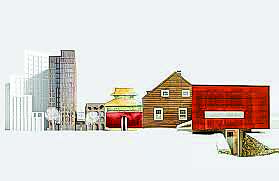
In the dynamic landscape of architectural design, the harmonisation of modern structures with historical contexts presents both a captivating opportunity and a formidable challenge. As societies embrace progress and innovation, preserving the cultural heritage embedded in historic environments becomes imperative. Yet, the task of striking a delicate balance between modernity and tradition requires thoughtful consideration of historical significance, architectural aesthetics, and community engagement. In this article, Ar. Bhuvan Kapila, Founder and Principal Architect of Workshop for Metropolitan Architecture(WMA) delves into the intricate strategies and nuanced approaches to seamlessly integrate traditional spirit into contemporary architecture.
Embracing the Spirit of Reuse
Modern architects are increasingly incorporating recycled materials into their designs. This strategy not only fosters environmental sustainability but also creates a tangible link to the past. Reusing existing brickwork, timber, or even stone from a demolished structure on a site injects a sense of history into the new. The textures and imperfections of these elements act as whispers of the past, grounding the modern design in its context. However, challenges arise in integrating these materials seamlessly. Existing materials may have limitations in size, strength, or availability. Also, their integration with modern building systems can require innovative solutions to ensure structural integrity and functionality.
Borrowing Vernacular Techniques
The vernacular architecture of a region is a treasure trove of practical wisdom adapted to local climate and materials. One can draw inspiration from these time-tested techniques to create buildings that are not only aesthetically pleasing but also environmentally responsive. For instance, incorporating traditional methods of passive cooling or utilising locally sourced, low-embodied energy materials can reduce the environmental footprint of a modern structure. However, directly replicating vernacular styles can appear forced or derivative. The challenge lies in reinterpreting these techniques for contemporary use while maintaining their essence.
Breathing New Life into Existing Structures
Adaptive reuse, the practice of transforming existing historical buildings into modern spaces, offers a sustainable and community-driven approach. This strategy allows for the preservation of a site’s character while injecting new life into a potentially underutilised structure. Adaptive reuse can range from converting a factory into a community center to transforming a church into a library. However, existing structures may have limitations in terms of layout, accessibility, or seismic resistance. Further, integrating modern building systems and amenities within the historical framework can require creative and costly solutions.
Replicating Traditional Architectural Details
Sometimes, the most effective way to bridge the gap between modern and historical is through the subtle use of replicated architectural details. This strategy involves incorporating elements like window mouldings, cornices, or rooflines that echo the surrounding historical architecture. These details can create a visual dialogue between the new and the old, fostering a sense of harmony within the streetscape. However, overreliance on replicated details can create a sense of inauthenticity or forced mimicry. The challenge lies in using these elements judiciously to create a conversation, not a copy.
By embracing these strategies and confronting their challenges, architects can create modern structures that celebrate the whispers of the past. The resulting buildings not only serve their function but also become storytellers, weaving a rich tapestry that connects the present to the historical narrative of a place.